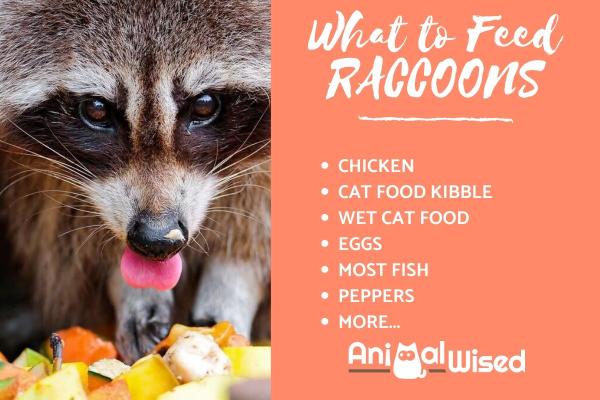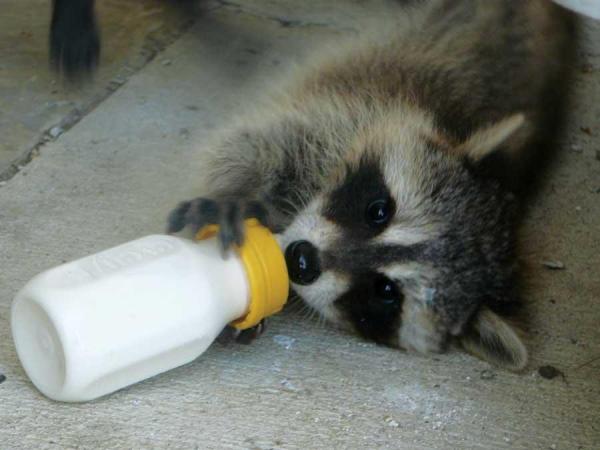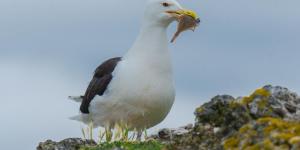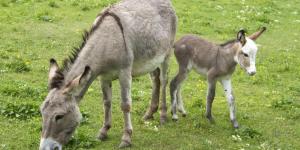What Do Raccoons Like to Eat?


If you find you have to take care of a raccoon, knowing what to feed them is vital. Raccoons are gregarious animals and are becoming common fixtures even in urban environments as they search out food. They are generally very intelligent animals with dexterous paws, making them capable of looking after themselves. However, you may come across an abandoned raccoon cub or an injured raccoon which needs looking after before they can be released back to the wild.
For this reason, you will need to know what do raccoons like to eat? AnimalWised looks into the diet of wild raccoons and see how pet raccoons are fed to shed some light on the matter.
Raccoons as pets
There is a growing trend of keeping raccoons as pets. Especially when they are cubs (or kits as they are also known), raccoons are adorable animals. With their masked faces, almost human-like paws and affectionate personality, it is easy to see why they have become popular. With videos being shared on the Internet of pet raccoons, this popularity seems to be growing significantly.
However, as is often the case with trends, not everything considers the repercussions of keeping raccoons as pets. Firstly, when they are cubs, they are relatively docile, cute and easy enough to care for. Due to their small size, any ruckus they cause is usually manageable. However, things change when they develop.
Juvenile and adult raccoons are very difficult to manage since they are mischievous, nocturnal and, due to their dexterity, able to cause a lot of havoc in the home. Since they are so difficult, only those with enough time, patience and resources are able to contain their behavior. However, this is not the only reason keeping raccoons as pets isn't a great idea:
- Raccoons are wild: unlike dogs and cats, raccoons have not gone through millennia of domestication. While they are intelligent, they are near impossible to train and will never become fully docile. Also, in the wild, they are able to have free reign of a large expanse of territory. Keeping them in the domestic environment limits them and affects their quality of life, especially when it comes to socializing within their species group.
- Habitat: if you do bring in a raccoon, you will need to have a lot of space to let them roam. This means a large garden at the least. They should not be homed in apartments and they need plenty of environmental enrichment to keep them entertained. Without it, they will become destructive.
- Ecology: since the responsibility of keeping raccoons as pets is so high, too many people are unable to meet it. This results in the inevitable abandonment of raccoons. As an invasive species[1], they can go into different ecosystems and wreak havoc. They can supplant other species by taking resources and simply disturb the often careful ecological balance of an area.
- Exotic pet trade: a demand for keeping raccoons as pets means there will be a business set up around it. Unfortunately, unscrupulous exotic pet traders prey on the desire to keep pet raccoons and will often keep them in abusive conditions. Is areas where importing or keeping raccoons is illegal, it can involve organized crime. It is something we have already seen with other exotic animals such as otters.
For these reasons, it is not advised to keep a raccoon as a pet. Only very knowledgeable wildlife rehabilitators should be charged with their care or those who have no other choice but to raise them.
Finding a wild raccoon in need
There are many types of raccoons, depending on where you live. If you find an adult raccoon, it is likely they will have no interest in being your pet. While they may come over to take some food or generally explore, they will be used to living in the wild and reluctant to give it up. Baby raccoons, however, may be discovered on their own. If they are it is usually because:
- The mother is gone and won't return
- Their den has been destroyed
- Their den is too hot and the little ones have left and become lost
- The mother is moving all the young to another place
- Predators have appeared
- A pet has arrived with a baby raccoon
In any of these situations, it is advisable to wait for the mother's return for a while. You will need to ensure you maintain a safe distance, otherwise the mother may not approach. If the mother does not return and you notice the kit is alert with their eyes open, you should take them immediately to the nearest wildlife recovery centre. There they will take care of feeding and caring for them until they can be released back into the wild.
On the other hand, if the raccoon's eyes are closed, it is likely they are dehydrated and/or hungry. In this situation, you will need to provide them some food and shelter. This way they have a better chance of survival until rehabilitators can take over.
Raccoons depend on their mother for 3 to 5 months, after which they should be able to fend for themselves. They are weaned at 12 weeks of age, although they generally remain with their mother and siblings for a year. They will open their eyes at about 3 weeks of life.

Caring for an abandoned raccoon
When you discover a baby raccoon has been abandoned, pick them up with a small blanket. It is important to wear some gloves as raccoons already have teeth at 4 weeks of age and can bite you if they get upset or confused. They will likely growl in fear.
Wrap the kit in the blanket and keep them warm. Place a towel in a cardboard box to mimic the baby raccoon's den. You can use an electric blanket to keep them extra warm if available, but make sure there is a protective blanket on top otherwise it can get too warm. A temperature of around 36 ºC/96 ºF is ideal.
Check that the baby raccoon doesn't have any injuries by examining their body. If you find any wounds, wash with antibacterial wash and warm water. Apply with a cloth, don't try to bathe them in a basin or bath. Look also for external parasites such as fleas and ticks, removing them when found. If you find lots of insects, it supports the idea they have been abandoned as their family should be grooming them. See a veterinarian as soon as possible.
Feeding a baby raccoon
Here we provide some practical information on what to feed a baby raccoon and how to do it. These factors will depend on their age. At the beginning, the raccoon won't like to drink anything other than milk as this is what their mother would be feeding them. Remember that when feeding milk, we should use a bottle with a nipple to mimic their mother's feeding.
- Newborn raccoon: at one week of age, the raccoon kit will weight between 60 and 140 g. We can see their eyes will be closed. The famous black mask on the raccoon's face will be only faintly visible if at all. We should provide them with some kitten milk which can be bought in any good pet store. They will need to eat about 5% of their body weight which should be between 30 and 70 ml (1 and 2.3 ounces). The milk should be warm at a little higher than body temperature. After feeding, wipe their genitals with a cloth so they can urinate. We should feed them about 8 times a day, with 3 hours in between each feeding.
- 2 weeks: at this point the baby raccoon should weigh about 190 to 225 g. They will still have their eyes closed and their belly will not have developed fur. At this time, we should increase the amount of food to between 95 and 113 ml (3.2 - 3.8 fl oz). We should reduce their feeding to 6 times per day.
- 3 weeks: the raccoon should weigh between 320 and 400 g. They will start to open their eyes around this time and their coat should be developing all over their body. We should increase the dose to between 160 and 300 ml (5.4 - 6.7 fl oz).
- 4 -5 weeks: increase the amount of milk according to their increase in weight. They should have about 5% of their body mass in milk.
- 6 weeks: at this point the raccoon should weigh between 750 and 820 g. We should reduce the amount of milk to between 520 and 550 ml (17.5 - 18.6 fl oz) per day and stop feeding them at night.
- 8 weeks: from this point on, we should start to wean the raccoon onto solid food. We need to offer it to them until they gradually accept it. Wet puppy or kitten food should be a suitable substitute. We should not increase the dosage of milk.
- 10 - 16 weeks: the raccoon should weigh around 2 kilos (c. 4 lbs) during this time. They should already we used to eating solid food and we should start removing milk from their diet. High-quality puppy food should make up about 2/3 of their diet. The remaining food should be made up of fresh fruit and vegetables. At this stage, you should let them eat as much as they like since they are in the stage of development when they need it. You will start to see what they like eating at this point. Also, they will need plenty of fresh drinking water, as well as a pool of water in which they can cool down.
After they are sufficiently weaned, we should place them in a large cage which contains a space to nest. Clean it often and ensure it is not in the cold. From 16 weeks of age, the raccoon should be independent. You can consider releasing them at this time. Simply leave the cage open and let them investigate. They may come back a few times before leaving.

Feeding an adult raccoon
While there are some foods raccoons generally like to eat, each one will be an individual. They will develop their own individual preferences. Raccoons are technically omnivorous animals and can find their necessary nutrients from a wide range of foods. They include:
- Chicken
- Turkey
- Cat food kibble
- Wet cat food
- Eggs
- Most fish
- Carrot
- Peppers
- Banana
- Seafood
- Watermelon
- Corn
- Rice
- Apple
As you can see there are a wide range of foods you can give to an adult raccoon. If a raccoon is in your care for a significant length of time, it is best to vary the type of food so they don't get bored. You can also test different foods out to see which are their favorites. However, you should never offer them red meat. Also, check their weight after 16 weeks to ensure they maintain a stable weight. They can be greedy animals and may develop obesity if we are not careful.
An older raccoon will continue to eat a variety of foods as explained above. We will need to reduce or increase the amount they eat according to their levels of physical activity. If they like to eat something that is high in fat, for example, we should remove this from their diet.

If you want to read similar articles to What Do Raccoons Like to Eat?, we recommend you visit our Healthy diets category.
1. CABI. (2019). Procyon lotor (raccoon). https://www.cabi.org/isc/datasheet/67856







